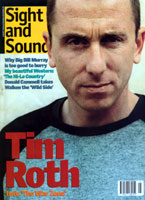Primary navigation

UK 1998
Reviewed by David Tse
Our synopses give away the plot in full, including surprise twists.
Rat is a teenage drug dealer in Woolwich, South London. He frequents the Underground dance club, where he is the only dealer working without the assent of Raymond, the shady promoter. Skye, a regular customer, promises Rat sex to get free drugs. Another girl Rat supplied overdoses. Raymond and the partygoers abandon the club. Raymond and his crew learn of Rat's involvement; they break in and wreck Rat's place. Rat returns and his flatmate Debbie throws him out.
Searching for a place to sleep, Rat visits his supplier's house but runs away from a stoned orgy. Raymond threatens to kill Rat so Rat buys a handgun from one of his mates. He shows up at his home, but his estranged mother won't let him in. He calls at Skye's flat. She sneaks out and takes him to a deserted park where they have hesitant sex for the first time. Incensed by Rat's maxim of looking out for no one but himself, she leaves. Finally Rat crashes at his best customer Richard's Chelsea flat. Raymond arrives, but before he and Richard agree on the reward Rat wakes up. Rat shoots and wounds Richard, and flees. He runs into Green Park underground station, and dives into the tunnels. Raymond and his bouncer are run over by a speeding train, but Rat survives by throwing his small body into the hollow of the tracks. He wanders out on to the South Bank, where he sits by the river and weeps.
The teenage boy wakes up in his room, surrounded by fashion magazine pages on the walls. Lighting up a joint, he knocks over a can of Coke, soaking the pornography on the floor. The boy has a hardened frown and an innocently open mouth, revealing the clenched teeth. He is a drug pusher. He goes to work on his bicycle. We follow him closely for one night, which turns out to be the longest night of his life.
There is plenty to be excited about in Paul Spurrier's low-budget debut. Spurrier, a former child actor, writes, directs and photographs this film; he has the eye of a fashion photographer compounded with the zeal and verve of a real film-maker. The film isn't quite Nil by Mouth street-level social realism - unless you accept it as an attempt at wedding the form to a commercially viable thriller plot. The use of handheld 16mm camera affords the film great mobility and immediacy. It's consistently and defiantly adventurous.
In chronicling the increasingly desperate 24 hours of a small-time drug dealer, Underground seems indebted to the recent movie Pusher. The film's freewheeling camera style, use of fast and slow motions, and depiction of blurry, hallucinatory club scenes might have been inspired by Fallen Angels or Clubbed to Death. But the details and flavour are distinctly London. The film has an extremely vivid sense of place, virtually embedding in its narrative a map of London as a postcolonial city. The film begins with a sunny, touristic montage of familiar imperial icons: the Houses of Parliament, the change of guards at Buckingham Palace, the Mall (complete with parodically cheerful music). It ends with Rat crossing the Thames, going against the morning rush of respectably suited office workers. In between, we go from grubby, green-grey Woolwich council estates to bare, smoky rave clubs in Elephant and Castle, deserted parks and squares, high-street shop windows glowing at night, posh Chelsea pads and finally the South Bank arts complex. Spurrier's hit-and-run filming technique gives the footage an uncontrived authenticity, and time and again the details give you jolts of recognition.
The action is edited and synchronised to the almost non-stop music. The soundtrack comprises beeping, pulsing trip hop bleeding into echoing Gothic riffs and riotous rap blasts when things get tough, finally mutating into a redemptive choir at the end. When a clubber overdoses, the sound is a menacing, rumbling Lynchian machine noise. The drug usage and underage sex could attract censure, but the scene showing the latter is actually the film's most touching. We don't see the act but are shown the outrageously beautiful foreplay of the two naked children's midnight frolic in a fountain, and the awkward recrimination that comes afterwards. Casting a virginal-looking teenager is possibly a manipulative stab at making this hustling drug dealer a more sympathetic protagonist. But this is a film that speaks the language of young Londoners: musically, visually, emotionally and topologically.